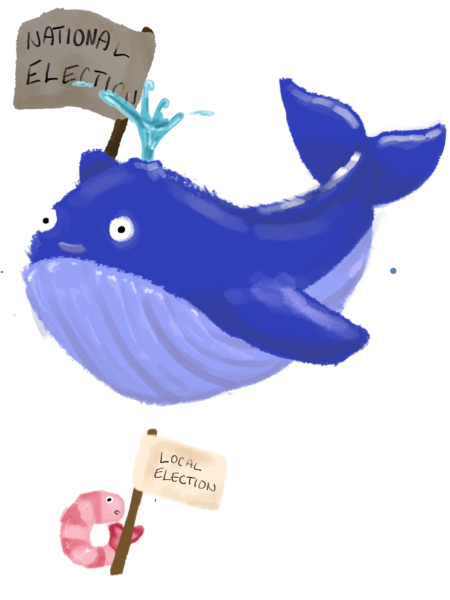
Come Nov. 5, the next president isn’t the only thing the people of San Mateo will be voting on. Charles Hansen and Nicole Fernandez are both vying for San Mateo District 2’s seat, while Danielle Cwirko-Godycki campaigns unopposed for District 4.
Much of peoples’ daily lives are controlled by people who enjoy the same public amenities they do, as opposed to far off federal governments.
“[A]t the local level, you can see your policies,” Hansen said. “When people say, ‘Oh, I’m not political,’ they just don’t know they are. It’s the air you breathe, it’s the sidewalk you walk, [it’s] everything that you have. [Everything] that you love … is a policy.”
Social media is constantly buzzing with opinions on candidates. Ask anyone in the hallways what they think of Trump or Harris, and they’ll at least recognize the names. The same can’t be said about those running for local government positions.
“If [local elections] were publicized more, and if they were brought up more in school and our history or government classes, [they] would reach the youth a lot better,” said Model UN social media manager and junior Class Vice President Charlie Harger. “People view [local government] as less important than larger government, because they think that a city councilman might not have as much authority or influence as a president would.”
National elections can also feel distant if one has no involvement in a higher level of politics. In contrast, many council members stress that community opinion is a priority when it comes to policy making.
“Each [council] meeting has opportunities for public comment. You don’t have to sign up in advance. We also have Zoom,” said San Mateo Councilman Adam Loraine. “You can also email the council … and it actually goes to each council member and the city manager and the city clerk. Not only do we get your comment, but the city manager may want to talk to department heads and give an official city response.”
Local government doesn’t end with the city council. If a student wanted to petition one of Aragon’s rules, they would speak to the school board, not the mayor. If someone notices an issue with the infrastructure of their townhouse, they would look to their Homeowners Association for future action.
Additionally, each neighborhood has its own personal association, where members meet regularly to discuss goals specific to their area. District 4 candidate Danielle Cwirko-Godycki saw the flood damage dealt to her and her neighbors’ homes and decided to rebuild her neighborhood association.
“As I started talking to residents, I learned that more and more people were impacted by the flooding … so I rallied the community together,” Cwirko-Godycki said. “We went to City Hall, and we petitioned the city council for emergency relief to help fortify the city … I actually worked with our city council to put together a ballot measure to secure $4.1 million a year in flood infrastructure.”
As of the 2020 election, about a third of eligible voters did not vote because they felt their vote had no effect on the outcome of the election. Local elections mitigate this feeling of powerlessness. With a much smaller voter pool of around 436,500 registered voters, in comparison to the 161.42 million nationwide, 1 vote has the same weight in local elections as 307 people nationally.
18-29 years-olds in particular have the lowest number of votes. While not often represented by actual politicians, young voices have their own growing power in the city of San Mateo.
“I was carried to the finish line successfully because of the work of young people and the vision of young people who felt like … they saw their vision of the future in me,” said Councilwoman Amourence Lee, the first Asian-American woman to serve on San Mateo’s city council.
Lee has pioneered a youth internship program for highschool students to be included in local politics. The Youth Group meets with Lee weekly, attends campaign meetings and directly interacts with the community from a more political angle. The members are included on the library board, parks and rec, senior, sustainability and infrastructure commissions.
“It’s a really great opportunity for people wanting to learn more about local politics, and people who want to help out with the community,” said sophomore and Youth Group member Lincoln Elliot. “It’s a good way to intrigue soon to be voters … introduce them to the new kind of things that they would implement into the community and … let them know what’s at stake when they’re voting.”
By the next presidential election every current member of Aragon’s community will be eligible to vote, but age isn’t a barrier stopping students from getting involved in politics. There are numerous government-based clubs held at Aragon, like Model United Nations and Harvard Model Congress, as well as governmental programs or internships outside of school.
“I joined [Student Equity and Class Counsel] because I wanted to [have] a bigger role in this community,” Harger said. “I wanted to have a bigger impact on the people around me.”
Age should not be a deterrent to political involvement. There are many ways to get involved at any scale, so long as one is actively looking.
“The old saying is, if you don’t have a seat at the table, you’re what’s on the menu,” Fernandez said. “That very much applies to politics … it will be your values at stake if you’re not there discussing the terms of whatever policy is being made.”




